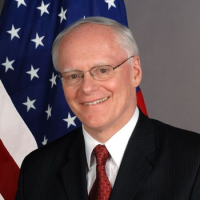
A blog of the Kennan Institute
By JAMES JEFFREY
Recent media reports on U.S. plans to support a Ukrainian insurgency, were Russia to invade, appear to reflect administration signaling if not necessarily policy. Given the likely Russian reaction to any Ukrainian insurgency, Washington needs to think its response through in more detail.
So far, it is not clear whether there are serious plans to support an insurgency; the rhetoric out of Washington may be simply saber-rattling to deter Russia from igniting a potentially fatal collapse of the European peace order. In support of the “no plans” scenario, Washington has a bipartisan habit of wishing away dangerous developments: President Obama declared that Putin’s 2015 move into Syria would merely get Russia stuck in a “quagmire,” a prediction that did not pan out; Vice President Dick Cheney in 2003 notoriously predicted that Iraqis would greet U.S. troops as liberators. Conjuring up an insurgency in Ukraine might be another example of this species of magical thinking.
But let us address the hypothetical. U.S. support for an insurgency would first require an insurgency to exist, and certain political and demographic changes in Ukraine suggest the country might find the wherewithal for an uprising against a Russian incursion. Ukraine is a huge country with a large population that has recently become significantly more anti-Russian. The country has a history of partisan warfare during World War II and has a long border with NATO states that might be willing to funnel arms and provide refuge. But the spark of any insurgency is difficult to discern in advance. It is a political-psychological phenomenon generated by chance and requiring the right leader in place, an ideology to sustain the opposition, outside support, and invader provocations or an inept counterinsurgency. It is hard for analysts, including, in this case, those among U.S. military experts and the Ukrainian leadership, to fathom in advance whether a population will rise up.
One thing that can be analyzed, however, is the likely Russian response, given the example of the Russian all-elements-of-power counterinsurgency in Syria. While the overall Russian military effort has not succeeded in finishing off ISIS, it did break the back of the mainstream Syrian armed opposition in a three-year counterinsurgency campaign, turning the tables on insurgents supported by, inter alia, the U.S. government, who were gaining ground against Assad.
The Russian approach included political flexibility and clever diplomacy, but the core was extreme brutality: indiscriminate bombing of civilian areas not just as collateral damage but as deliberate policy. Assad’s own troops had had difficulty coping with a large, highly motivated Syrian Sunni Arab insurgency. The Russian bombing campaign, however, rapidly gained the upper hand, not only by waging terror against those supporting the resistance but also by destroying their refuge and sources of sustenance, from food to medical care. Russia itself did not engage in but turned a blind eye to even more brutal tactics employed by its Syrian and Iranian-backed allies. Those tactics included chemical weapons attacks, the incarceration of hundreds of thousands, mass executions, and widespread torture.
Russia also backed Assad’s strategy of ethnic cleansing, upping the costs of opposition for the international community by driving many millions—eventually half the population—from their homes. Almost six million refugees fled to Turkey, Jordan, and Lebanon and a further million to Europe, creating a political crisis in the European Union. And the cost to neighboring states and the international community in various refugee and humanitarian relief efforts has been almost $100 billion since 2011, far more than Russia’s intervention has cost that country.
Russia complemented brutal military action with cynical political flexibility in dealing with defeated opposition elements and foreign sponsors. Moscow negotiated four local ceasefires with Turkey, a major opposition supporter, and one with the United States, the Da Nang Agreement. It then allowed Assad to break them all, with the exception of the 2018–2019 Idlib demilitarization agreement, which was enforced by Turkish ground troops. Russian military personnel, once the balance in a given area had shifted to their favor, cut deals with opposition leaders, sometimes allowing them to retreat, at other times to keep light weapons. Russian troops even protected opposition personnel at times from the Syrian army and Iranian militias. The result was cheap victories without a lengthy, bloody rooting out of holdouts.
Moscow’s diplomacy was closely coordinated with its military advances, seeking to demoralize international support for the armed Syrian opposition while portraying Russia as the “go-to capital” for neighbors’ specific Syrian security concerns. These ranged from Turkey’s fear of the PKK to Israel’s concern with Iranian missiles, and everyone’s angst over refugee flows. As a result, an international community in principle opposed to Russia’s Syria policy had difficulty uniting over a common action plan. Russia reinforced this advantage in the UN Security Council, agreeing to a UN Syria peace process under Resolution 2254 while in practice ensuring that UN condemnation of Assad remained toothless, and pressuring the council over humanitarian assistance deliveries.
In a nutshell, Russia’s approach to counterinsurgency was the opposite of that of the United States in Afghanistan: a small rather than a large footprint, the deliberate commission of atrocities as opposed to a concern for civilian casualties, tolerance of Assad’s foibles versus transformational nation building, co-optation of the internal and international opposition through bribes and blackmail versus a binary “us versus them” posture—with an ultimate result of success versus failure.
Any Ukrainian insurgency can expect a similar ferocious, politically clever Russian response. Nevertheless, there is a silver lining, albeit one that comes with its own risks, in Russia’s Syria engagement. When faced there with the military forces of powerful states—Israel, Turkey, and the United States—willing to defend their own security, Russia, after initial challenges, has sought compromise. The keys to that outcome were, first, clarity about what all the major actors’ core interests were, and second, the willingness of each side to respect the others’ interests.
U.S. CIA strategists crafted what became known as “Moscow rules” for covert operations during the Cold War to contain the Soviet Empire’s hegemonic aspirations. Policymakers and government officials should beware Russia’s deployment of its proven successful “Syria rules” against insurgencies elsewhere that threaten contemporary Moscow’s aspirations, especially in Ukraine.
The opinions expressed in this article are those solely of the authors and do not reflect the views of the Kennan Institute.
Author

Former ambassador to Iraq and Turkey, and Special Envoy to the Global Coalition To Defeat ISIS

Kennan Institute
After more than 50 years as a vital part of the Wilson Center legacy, the Kennan Institute has become an independent think tank. You can find the current website for the Kennan Institute at kennaninstitute.org. Please look for future announcements about partnership activities between the Wilson Center and the Kennan Institute at Wilson Center Press Room. The Kennan Institute is the premier US center for advanced research on Eurasia and the oldest and largest regional program at the Woodrow Wilson International Center for Scholars. The Kennan Institute is committed to improving American understanding of Russia, Ukraine, Central Asia, the South Caucasus, and the surrounding region through research and exchange. Read more


Middle East Program
The Wilson Center’s Middle East Program serves as a crucial resource for the policymaking community and beyond, providing analyses and research that helps inform US foreign policymaking, stimulates public debate, and expands knowledge about issues in the wider Middle East and North Africa (MENA) region. Read more

Explore More in The Russia File
Browse The Russia File
Chechnya as a Model of Modern Russia

Russia’s Indigenous Communities and the War in Ukraine

Gas and Power in a Changing US–Russia Relationship

